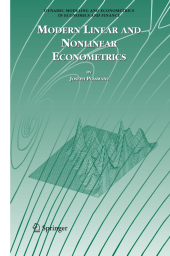 Neuerscheinungen 2011Stand: 2020-01-07 |
Schnellsuche
ISBN/Stichwort/Autor
|
Herderstraße 10
10625 Berlin
Tel.: 030 315 714 16
Fax 030 315 714 14
info@buchspektrum.de |

Joseph Plasmans
Modern Linear and Nonlinear Econometrics
2011. xxii, 382 S. 235 mm
Verlag/Jahr: SPRINGER, BERLIN 2011
ISBN: 1-441-93831-1 (1441938311)
Neue ISBN: 978-1-441-93831-2 (9781441938312)
Preis und Lieferzeit: Bitte klicken
The basic characteristic of Modern Linear and Nonlinear Econometrics is that it presents a unified approach of modern linear and nonlinear econometrics in a concise and intuitive way. It covers four major parts of modern econometrics: linear and nonlinear estimation and testing, time series analysis, models with categorical and limited dependent variables, and, finally, a thorough analysis of linear and nonlinear panel data modeling. Distinctive features of this handbook are:
-A unified approach of both linear and nonlinear econometrics, with an integration of the theory and the practice in modern econometrics. Emphasis on sound theoretical and empirical relevance and intuition. Focus on econometric and statistical methods for the analysis of linear and nonlinear processes in economics and finance, including computational methods and numerical tools.
-Completely worked out empirical illustrations are provided throughout, the macroeconomic and microeconomic (household and firm level) data sets of which are available from the internet; these empirical illustrations are taken from finance (e.g. CAPM and derivatives), international economics (e.g. exchange rates), innovation economics (e.g. patenting), business cycle analysis, monetary economics, housing economics, labor and educational economics (e.g. demand for teachers according to gender) and many others.
-Exercises are added to the chapters, with a focus on the interpretation of results; several of these exercises involve the use of actual data that are typical for current empirical work and that are made available on the internet.
What is also distinguishable in Modern Linear and Nonlinear Econometrics is that every major topic has a number of examples, exercises or case studies. By this `learning by doing´ method the intention is to prepare the reader to be able to design, develop and successfully finish his or her own research and/or solve real world problems.
Acknowledgements.- Part I. Linear and Nonlinear Econometric Inference: Estimation and Testing. Estimation in Linear and Nonlinear Models. Generalized Methods of Moments. Testing in Linear and Nonlinear Models.- Part II. Time Series Analysis. A Typology of Dynamic Models. Univariate ARIMA Models. Cointegration and Transfer Functions. Multivariate Time Series. Varying Parameters Models.- Part III. Categorical and Limited Dependent Variables. Discrete Choice Models. Limited responses, duration and count data.- Part IV. Panel Data Analysis. Linear Panel Data Models. Nonlinear Panel Data Models.- A. Nonlinear Optimization and Estimation.- B. Mathematical Formulation of GMM.- C. Stability Criteria for AR(p) Models.- D. MLE of the RSM with Endogenous Prices.- E. Volatility Modeling.
From the reviews:
"This textbook presents a unified approach of linear and nonlinear econometrics to the application of recent research topics in applied economics. ... The book is written for final year bachelor and master students, but it may also be useful for practitioners in business and public institutions ... . Given that most econometric textbooks deal either with linear or with nonlinear econometrics, this book bridges the gap by treating each topic with equal importance and by using a unified notation, to present the different approaches." (Herbert S. Buscher, Zentralblatt MATH, Vol. 1098 (24), 2006)


